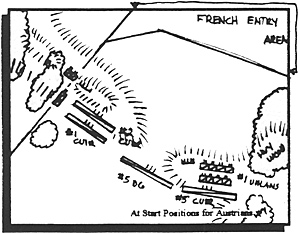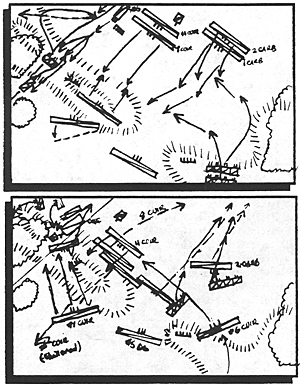 This game was fought out using 15mm figures on a 5' x 4' table in one afternoon. The Austrian forces consisted of the 1st, 2nd, 6th cuirassiers (6 sqds each), 5th dragoons (6 sqds), 1st uhlans (8 sqds), and 10th hussars (4 sqds), 2 six gun 6 lb. horse batteries, I corps co. (fair (, and 3 brigade COs (fair), for a total of 4320 men and 12 guns. The French force consisted of; 1st, 2nd carbiniers (4 sqds each), 8th, 11th cuirassiers (4 sqds each), 7th, 17th dragoons (4 sqds each), 13th, 16th chassuers a cheval (4 sqds each), 8th hussars (4 sqdns). two six-gun 8lb and one six-gun 4lb horse batteries, 1 corps co. (excellent), 2 division cos. (excellent), and 3 brigade cos. (excellent), for a total of 5220 men and 18 guns.
This game was fought out using 15mm figures on a 5' x 4' table in one afternoon. The Austrian forces consisted of the 1st, 2nd, 6th cuirassiers (6 sqds each), 5th dragoons (6 sqds), 1st uhlans (8 sqds), and 10th hussars (4 sqds), 2 six gun 6 lb. horse batteries, I corps co. (fair (, and 3 brigade COs (fair), for a total of 4320 men and 12 guns. The French force consisted of; 1st, 2nd carbiniers (4 sqds each), 8th, 11th cuirassiers (4 sqds each), 7th, 17th dragoons (4 sqds each), 13th, 16th chassuers a cheval (4 sqds each), 8th hussars (4 sqdns). two six-gun 8lb and one six-gun 4lb horse batteries, 1 corps co. (excellent), 2 division cos. (excellent), and 3 brigade cos. (excellent), for a total of 5220 men and 18 guns.
The Austrian forces started out set up on the table with hidden deployment for those units the French would not be able to see as they came on the table. Their objective was to hold the French pursuing force from exiting off the road down which the main Austrian Army had retired earlier. The French play could bring on one brigade per turn. The French objective was to overthrow any resistance and exit a majority of his forces off the road behind the Austrian position.
The slopes were all classified as level 1 (gentle), while the woods were all classified as heavy woods (with visibility into then of 1"). The roads could only be used, by limbered artillery or cavalry in road mode. The slopes all had a crest line marked on them, any unit within 1" (50 yards) of the line would be visible to units on the other side of the slope.
The action started with the French player toying the Cuirassier brigade on west of the mouth road. The next unit one was the Carabinier brigade. The 8 lb. batteries tow deployed so as to take the Austrian battery on the south ridge line under fire. At first they were beyond their effective range (i.e. over 1/2 of their total range) so had to be prolonged closer. This enabled them to suppress the Austrian guns. The Austrian guns realized that long-range shooting at enemy guns would be a waste so tried to concentrate on the Cuirassiers behind the guns (with little effect).
While this was going on two squadrons of the 10th Meszaros Hussars had moved to take the French Dragoon Brigade in the flank as it was moving up to support the Cuirassiers. Unfortunately for the Neszaros the French 8th Hussars arrived just in time to send them reeling back (they received a repulsed result and then a retreat result the next turn).
In the meantime the Austrian Franz Josef Cuirassiers 12 had moved up just below the crest of the ridge awaiting the French onslaught. The Aiser Cuirassiers shifted their front to be able to meet a developing flanking movement by the French 7th Dragoons along the road. The French Dragoons had charged and were fighting the rest of the Austrian Hussars just to the south of the ridge crest line. The Hussars were slowly being driven back and then they were forced to retreat exposing the Horse guns.
It was at this point that the French heavy cavalry case forward. The Cuirassier brigade case forward with the Carabiniers in support. The Austrians saw their chance and the squadrons of Franz Josef were ordered to charge! At the sale time the 8 squadrons of the Werveldt Uhlans came over the ridge to outflank the Carabiniers. At first the French were confident of victory but then the French commander realized that his whole assault was going to be compromised by the advance of the Austrian Uhlans. The French and Austrian Cuirassiers fought it out with the 1st Carabiniers adding in, but 4 squadrons of Uhlans managed to hit the 1st in the flank while the other 4 squadrons pinned the 2nd Carabiniers.
The 8th Cuirassiers were finally forced back in a retreat and the 1st Carabiniers were being slowly driven back by the Uhlans. Both these French formations were forced back onto and through friendly supporting regiments which allowed the Austrian Cuirassiers $2 to regain order, while at the same time the Uhlans lost their heads and continued to charge after the Carabiniers. Lastingly the Uhlans continued to come out on top in each of the melees!
As the action in the center and Austrian right was taking place the French commander had been attempting to turn the Austrian left with his light division and the Dragoons. As stated previously the 7th Dragoons had uncovered the Austrian horse guns on top of the ridge. They were now launched in a charge to attempt to overrun then. The gunners had managed to get their guns turned to face this onrushing threat in enough time to deliver canister at pointblank range which managed to totally halt the Dragoons forward progress.
 It was now that the Austrian commander sent the Kiser Cuirassiers in a charge up the back side of the ridge into the disorganized Dragoons and the head of 13th CaC (who were attempting to get out of column. The Dragoons were sent flying back but the worse was the fate of the 13th CaC. Their column was all but surrounded by the Cuirassiers, the carnage was great and those who where not killed or wounded were captured! This did allow time for the corps 4 lb. battery to get unlimbered in order to meet the expected rush of the victorious Austrian Cuirassiers. Unfortunately for the French their guns did not have the same measure of success as the Austrians.
It was now that the Austrian commander sent the Kiser Cuirassiers in a charge up the back side of the ridge into the disorganized Dragoons and the head of 13th CaC (who were attempting to get out of column. The Dragoons were sent flying back but the worse was the fate of the 13th CaC. Their column was all but surrounded by the Cuirassiers, the carnage was great and those who where not killed or wounded were captured! This did allow time for the corps 4 lb. battery to get unlimbered in order to meet the expected rush of the victorious Austrian Cuirassiers. Unfortunately for the French their guns did not have the same measure of success as the Austrians.
By this time the French 11th Cuirassier had gotten itself straightened out and was launched into the Austrian 2nd Cuirassier. The Austrians had not completed their reorganization and were repulsed on the first shock and then quickly shattered by the desperation of the French charge!
The impetus of the charge carried the French into the flank of the Austrian 1st Cuirassiers which, were also being hit by regimental columns of the 17th Dragoons and 8th Hussars.
The Austrians in response to this had moved the #6 Cuirassiers out onto the plain and sent them into the flank of the French 11th Cuirassiers. At the same time the Austrian #5 Dragoons were being positioned to cover the back side of the slope and the horse guns were now also being brought back to a new position. And what of the Uhlans? Well they were now in total pursuit of the defeated French Carabinier brigaae! So the Austrian commander had nothing to fear from his right flank.
It was now late in the day with the light fading fast.
The French commander realized the futility of the situation. He only had the 17th Dragoons and 8th Hussars in any kind of decent shape. The 7th Dragoons were routed, 16th CaC gone, one battery overrun, his two heavy brigades a shambles. The Austrians still had the #5 Dragoons untouched, #6 Cuirassiers in good shape, #1 Cuirassiers damaged but not out of the fight, the Uhlans were off chasing the French heavies but not badly hurt. The French commander decided to break off the engagement before things got any worse.
This game was played between Chase Hall (French) and myself (Austrians). We both agreed that the Austrians having the hidden deployment was an excellent way to produce the fog of war (though we both knew the total makeup of each others forces). As the Austrian player I made extensive use of my Brigade leaders spotting for the regiments under their command. This enabled me to keep my units unraveled to the other side for as long as possible. Chase agreed with me that the main problem with his assault was not getting the artillery to properly prepare the Austrian position for the assault , that he got to impatient and took the suppression of my horse guns as enough of a signal to move forward.
Also he move his Carabiniers too close to one another and that when the critical time came the second line could not maneuver enough to meet the threat of my Uhlans as they moved onto his flank. As I have been playing this version of Houserules more and more I find myself liking the repulse result more aid more (when you compare morale roles if one side beats the other side by sore than 5 the other side loses status and must fall back in the next turn.) I find it causes one to seriously consider using your leader bonus in the combat which of course then brings up the potential for leader casualties (the benefits and detriments are more for the French as they have the better commanders).
Back to Table of Contents The Messenger April 1994
Back to The Messenger List of Issues
Back to MagWeb Magazine List
© Copyright 1994 by HMGS/PSW.
This article appears in MagWeb.com (Magazine Web) on the Internet World Wide Web.
Other articles from military history and related magazines are available at http://www.magweb.com